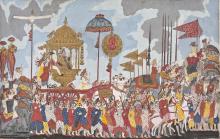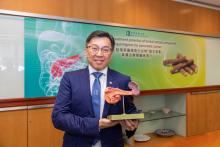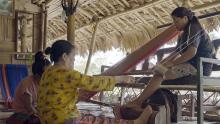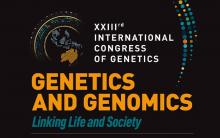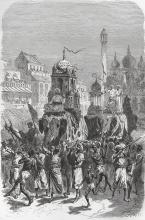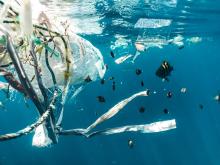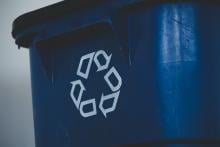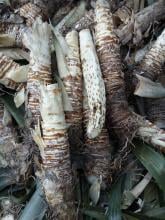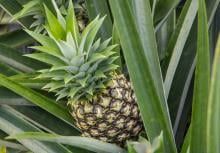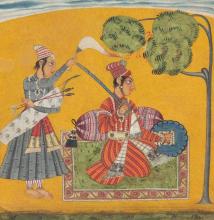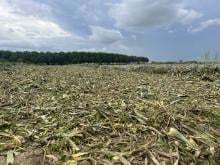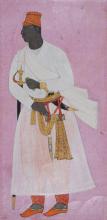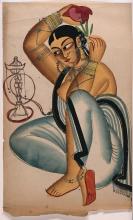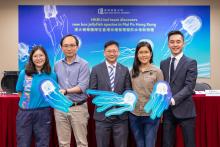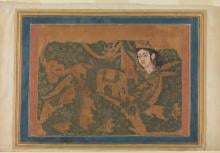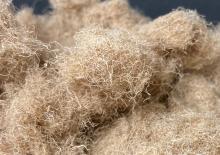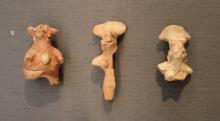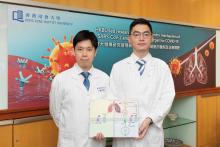Research Highlights
News
24 Aug 2023
Study suggests broad-spectrum vaccines with wide coverage necessary to achieve effective immunity against future, functionally-distinct variants.
14 Aug 2023
In the early seventeenth century, a new painting tradition — characterised by its use of bold colours, gilding and gem-setting — emerged in the Thanjavur region of southern India. While Thanjavur paintings originally featured gods and saints, the tradition grew to incorporate secular subjects owing to a range of influences over the next several centuries, including Mughal, Maratha, and European art. Thanjavur paintings continue to be popular as memorabilia and worship objects, and are one the most recognisable South Indian painting styles today.
07 Aug 2023
A research led by scientists of Hong Kong Baptist University (HKBU) found that isoliquiritigenin (ISL), a flavonoid isolated from the Chinese herbal medicine licorice, can inhibit pancreatic cancer progression. It may also enhance the efficacy of conventional chemotherapeutic drugs in treating pancreatic cancer. It is the first time that a research group reported the anticancer potential of ISL in treating pancreatic cancer.
31 Jul 2023
Backstrap looms are portable weaving contraptions with a component that is tied around the weaver’s waist, thereby engaging the weaver’s entire body in the process of creating textile out of warp and weft. Historical and archaeological evidence suggests that these looms, which presumably date as far back as the Bronze Age in China, have been, and continue to be, used by indigenous communities worldwide.
28 Jul 2023
Newcastle University (UK) and the Energy Research Institute at Nanyang Technological University hosted a UK-Singapore symposium funded by the UK Government in April 2023. It aimed to foster partnerships and research for widespread electric vehicle adoption. The event featured discussions on technology, economics, and policy over three days, encouraging joint collaboration in advanced electric transport research and commercialization.
20 Jul 2023
Thursday at the International Congress of Genetics in Melbourne
19 Jul 2023
From big, permanent structures within imambaras to palm-sized ones made of cigarette boxes and coloured paper, tazias are replicas of the tomb of Imam Hussain which play a significant role in the rituals observed during Muharram. They were initially popularised by the Mughals for those royals who were unable to visit the actual tomb but the tradition continues, even today, when photographic images of the tomb are widely available — as a mode of creative expression or, perhaps more, as a performance of homage.
18 Jul 2023
Research stories from the International Congress of Genetics in Melbourne Tuesday 18 July 2023
18 Jul 2023
Highlights from the first two days of the 23rd International Congress of Genetics, Melbourne Australia
For the next six days we will hear how genetics has transformed medicine, food, conservation, and almost every area of human activity.
04 Jul 2023
The use of veterinary antibiotics is not uncommon in the fields of animal husbandry and fisheries to speed up growth and prevent disease. However, residual antibiotics may damage human gut microbiota, promote antibiotic resistance, and even delay the growth and development of brain cells, posing hazards to human health.
03 Jul 2023
Comprising over 750 rock shelters — of which over a hundred are painted — the Bhimbetka caves are perhaps the earliest known repository of art in South Asia. These prehistoric paintings illustrate hunting scenes as well as scenes of collective rituals and processions. Although their purposes remain unknown, Bhimbetka paintings provide immense historical information about humans, animals and their relationship with nature and culture.
22 Jun 2023
Researchers from Newcastle University, led by Dr Kheng Lim Goh, have developed a cost-effective Cellular Automata (CA) model for predicting marine plastic movement. Findings from model predictions align well with traditional particle-tracking models, suggesting its potential as a valuable tool for assessing marine plastic pollution and mitigation strategies.
22 Jun 2023
An international team of researchers from India and Singapore, led by Associate Professor Kheng Lim Goh from Newcastle University in Singpaore, has examined the impact of plastic waste management on creating a new type of clean-energy device, Tribo-electric nanogenerator. It compares recycling practices in Singapore and India, highlighting the importance of waste policies and infrastructure for successful recycling of plastics for making the clean-energy device. Challenges include contamination and decreased material quality with recycling.
22 Jun 2023
An international team of researchers revisited the fundamentals of Negative Poisson's ratio structure (NPRS) and investigated its creation using laminated carbon fiber reinforced plastics, a strong and lightweight material. Their objective was to gain a deeper understanding of the process and explore potential applications, aiming to unlock new possibilities and advancements in the field of materials science for sustainability.
19 Jun 2023
Elaborately carved with female figures and floral motifs, ringstones dating to the 3rd and 2nd centuries BC are amongst the most enigmatic artefacts of Mauryan and Shunga art. Scholars continue to speculate about their use, and believe that they may have been used as amulets and ritualistic objects or designators. Discover more about these ancient artefacts through this article.
18 Jun 2023
A team of researchers from universities in Thailand and Malaysia have collaborated to develop a unique kind of bioplastic sheet that is good for the environment and can decompose naturally. They made this bioplastic sheet using a byproduct of the bromelain industry which used the leftover pineapple stems from agricultural waste. This new type of bioplastic sheet has the potential to be used as single-use packaging material, as an alternative to the use of harmful plastic sheet, contributing to a more sustainable way of doing business and promoting a circular economy.
07 Jun 2023
Scientists from Thailand, France and Singapore have conducted groundbreaking research using both tiny cellulose nanofibers (CNF) and long pineapple leaf fibers (PALF) to create stronger materials. They added varying amounts of CNF to epoxy and found that 1% CNF greatly increased impact strength. PALF-epoxy composites showed significant flexibility and strength improvements. Combining CNF and PALF resulted in a remarkable increase in impact strength. The findings could revolutionize stronger material development.
04 Jun 2023
Beginning in the fifteenth century, until the nineteenth century, artists turned to classical music for inspiration, combining painting, allegory and music to create a genre known as Ragamala painting. Ragas — melodic frameworks central to Indian classical music — date back to nearly the fifth century, and each major raga is meant to evoke a particular mood or atmosphere, a season and a time of day. Ragamala paintings are distinctive for their nuanced depiction of emotions through environmental metaphors and imagery that often includes a hero or a heroine or both.
25 May 2023
A group of researchers from universities in Thailand and Malaysia have collaborated to develop a unique kind of film that is good for the environment and can decompose naturally. They made this film using leftover pineapple stems, which helps reduce the use of harmful plastic films. This new film has the potential to be used as packaging material, contributing to a more sustainable way of doing business and promoting a circular economy.
22 May 2023
From its origins as a wide sash worn as a part of ceremonial, military and everyday dress in the Indian subcontinent, to becoming a part of British military clothing that was thought to guard against cholera, the cummerbund has had a storied legacy. Read about how this humble accessory evolved over the years.
08 May 2023
In operation from 1863 to 2016, Bourne and Shepherd was one of the first commercial photography studios in India, known for architectural, landscape and topographical photographs, as well as portraits of Indian nobility, British officials and European travellers. While these images found traction as souvenirs, the studio’s photographs were also widely utilised in the scientific community for the topographical and sociological study of the Indian subcontinent.
04 May 2023
HKBU joint research suggests that urine cytomegalovirus test facilitates early prediction of AIDS end-organ diseases
23 Apr 2023
Born out of the changing society of nineteenth-century Calcutta, Kalighat painting was a popular medium among the patuas (painters) who worked in the vicinity of the Kalighat temple. Though these paintings were originally intended to be souvenirs for devotees visiting the temple and featured primarily Hindu imagery, they expanded over time to include other religious traditions as well as socio-political commentary.
18 Apr 2023
A Hong Kong Baptist University (HKBU)-led team has discovered a new species of box jellyfish in the Mai Po Nature Reserve in Hong Kong. The new jellyfish species, which belongs to the family Tripedaliidae, was named Tripedalia maipoensis by the research team. It is the first discovery of a new box jellyfish species from the waters of China. The discovery also adds a fourth species to the Tripedaliidae family.
09 Apr 2023
Often regarded as Prophet Muhammad's vehicle in Islamic mythology, the Buraq is a winged creature often depicted with a human head and the body of a horse. It has been depicted in visual art across the Islamic world and continues to be a motif used by artists in the region.
29 Mar 2023
An international team of scientists is helping to reduce carbon emissions into the atmosphere by exploring different natural fibres and blending the natural fibres in plastics to make light-weight and strong green composite materials for the construction and automotive industries.
26 Mar 2023
These figurines from more than 4000 years ago, provide insights into the material culture of one of the oldest Bronze Age Civilizations, the Indus Valley Civilization.
24 Mar 2023
Scientists in Singapore converted fruit waste into a solar absorber called Mxene to develop an efficient and sustainable water desalination process.
20 Mar 2023
Scientists from Alliance University, Bangalore, Birla Institute of Technology Mesra, Inha University, Hanyang University, South Korea, and Newcastle University in Singapore have developed a new and straightforward approach to turn used COVID-19 facemasks into potential absorbent materials that can be employed for carbon capture from atmosphere.
20 Mar 2023
A study led by scientists from Hong Kong Baptist University (HKBU) has identified a protease called MT1-MMP that is a major host factor behind the infectivity of the SARS-CoV-2 virus in the human body, which leads to the infection of COVID-19 and multi-organ failure. By applying a humanised antibody called 3A2 that can inhibit the activity of MT1-MMP, the viral load of infected mice was reduced by almost 90%. The research team also demonstrated that the protease is a potential therapeutic target for COVID-19.
Events
Sorry, no events coming up for this topic.
Researchers
Sorry, no researchers coming up for this topic.
Giants in history
Sorry, no researchers coming up for this topic.


